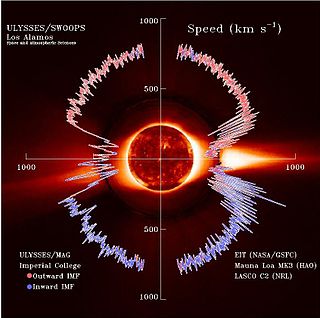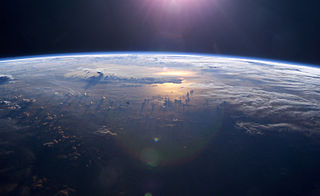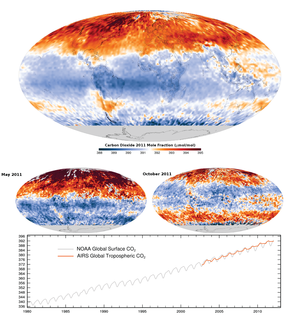Related Research Articles

Earth is the third planet from the Sun and the only astronomical object known to harbour and support life. 29.2% of Earth's surface is land consisting of continents and islands. The remaining 70.8% is covered with water, mostly by oceans, seas, gulfs, and other salt-water bodies, but also by lakes, rivers, and other freshwater, which together constitute the hydrosphere. Much of Earth's polar regions are covered in ice. Earth's outer layer is divided into several rigid tectonic plates that migrate across the surface over many millions of years, while its interior remains active with a solid iron inner core, a liquid outer core that generates Earth's magnetic field, and a convective mantle that drives plate tectonics.

The Miller–Urey experiment was a chemical experiment that simulated the conditions thought at the time (1952) to be present on the early Earth and tested the chemical origin of life under those conditions. The experiment at the time supported Alexander Oparin's and J. B. S. Haldane's hypothesis that putative conditions on the primitive Earth favored chemical reactions that synthesized more complex organic compounds from simpler inorganic precursors. Considered to be the classic experiment investigating abiogenesis, it was performed in 1952 by Stanley Miller, supervised by Harold Urey at the University of Chicago, and published the following year.

The solar wind is a stream of charged particles released from the upper atmosphere of the Sun, called the corona. This plasma mostly consists of electrons, protons and alpha particles with kinetic energy between 0.5 and 10 keV. The composition of the solar wind plasma also includes a mixture of materials found in the solar plasma: trace amounts of heavy ions and atomic nuclei such as C, N, O, Ne, Mg, Si, S, and Fe. There are also rarer traces of some other nuclei and isotopes such as P, Ti, Cr, 54Fe and 56Fe, and 58Ni, 60Ni, and 62Ni. Superposed with the solar-wind plasma is the interplanetary magnetic field. The solar wind varies in density, temperature and speed over time and over solar latitude and longitude. Its particles can escape the Sun's gravity because of their high energy resulting from the high temperature of the corona, which in turn is a result of the coronal magnetic field.

Terraforming or terraformation is the hypothetical process of deliberately modifying the atmosphere, temperature, surface topography or ecology of a planet, moon, or other body to be similar to the environment of Earth to make it habitable by Earth-like life.

Svante August Arrhenius was a Swedish scientist. Originally a physicist, but often referred to as a chemist, Arrhenius was one of the founders of the science of physical chemistry. He received the Nobel Prize for Chemistry in 1903, becoming the first Swedish Nobel laureate. In 1905, he became director of the Nobel Institute, where he remained until his death.

Climate variability includes all the variations in the climate that last longer than individual weather events, whereas the term climate change only refers to those variations that persist for a longer period of time, typically decades or more. In addition to the general meaning in which "climate change" may refer to any time in Earth's history, the term is commonly used to describe the current climate change now underway. In the time since the Industrial Revolution, the climate has increasingly been affected by human activities that are causing global warming and climate change.
Paleoclimatology is the study of climates for which direct measurements were not taken. As instrumental records only span a tiny part of Earth's history, the reconstruction of ancient climate is important to understand natural variation and the evolution of the current climate.

The hydrosphere is the combined mass of water found on, under, and above the surface of a planet, minor planet, or natural satellite. Although Earth's hydrosphere has been around for about 4 billion years, it continues to change in shape. This is caused by seafloor spreading and continental drift, which rearranges the land and ocean.

The Gaia hypothesis, also known as the Gaia theory, Gaia paradigm, or the Gaia principle, proposes that living organisms interact with their inorganic surroundings on Earth to form a synergistic and self-regulating, complex system that helps to maintain and perpetuate the conditions for life on the planet.

Wallace "Wally" Smith Broecker was an American geochemist. He was the Newberry Professor in the Department of Earth and Environmental Sciences at Columbia University, a scientist at Columbia's Lamont-Doherty Earth Observatory and a sustainability fellow at Arizona State University. He developed the idea of a global "conveyor belt" linking the circulation of the global ocean and made major contributions to the science of the carbon cycle and the use of chemical tracers and isotope dating in oceanography. Broecker popularized the term "global warming". He received the Crafoord Prize and the Vetlesen Prize.

Oceanic anoxic events or anoxic events (anoxia conditions) describe periods wherein large expanses of Earth's oceans were depleted of dissolved oxygen (O2), creating toxic, euxinic (anoxic and sulfidic) waters. Although anoxic events have not happened for millions of years, the geological record shows that they happened many times in the past. Anoxic events coincided with several mass extinctions and may have contributed to them. These mass extinctions include some that geobiologists use as time markers in biostratigraphic dating. On the other hand, there are widespread, various black-shale beds from the mid-Cretaceous which indicate anoxic events but are not associated with mass extinctions. Many geologists believe oceanic anoxic events are strongly linked to the slowing of ocean circulation, climatic warming, and elevated levels of greenhouse gases. Researchers have proposed enhanced volcanism (the release of CO2) as the "central external trigger for euxinia."

Ocean acidification is the ongoing decrease in the pH value of the Earth's oceans, caused by the uptake of carbon dioxide (CO
2) from the atmosphere. The main cause of ocean acidification is the burning of fossil fuels. Ocean acidification is one of several effects of climate change on oceans. Seawater is slightly basic (meaning pH > 7), and ocean acidification involves a shift towards pH-neutral conditions rather than a transition to acidic conditions (pH < 7). The concern with ocean acidification is that it can lead to the decreased production of the shells of shellfish and other aquatic life with calcium carbonate shells, as well as some other physiological challenges for marine organisms. The calcium carbonate shelled organisms can not reproduce under high saturated acidotic waters. An estimated 30–40% of the carbon dioxide from human activity released into the atmosphere dissolves into oceans, rivers and lakes. Some of it reacts with the water to form carbonic acid. Some of the resulting carbonic acid molecules dissociate into a bicarbonate ion and a hydrogen ion, thus increasing ocean acidity (H+ ion concentration).
A runaway greenhouse effect occurs when a planet's atmosphere contains greenhouse gas in an amount sufficient to block thermal radiation from leaving the planet, preventing the planet from cooling and from having liquid water on its surface. A runaway version of the greenhouse effect can be defined by a limit on a planet's outgoing longwave radiation which is asymptotically reached due to higher surface temperatures evaporating a condensable species into the atmosphere, increasing its optical depth. This positive feedback means the planet cannot cool down through longwave radiation and continues to heat up until it can radiate outside of the absorption bands of the condensable species.
James Fraser Kasting is an American geoscientist and Distinguished Professor of Geosciences at Penn State University. Kasting is active in NASA's search for habitable extrasolar planets. He is considered a world leader in the field of planetary habitability, assessing habitable zones around stars. He was elected a member of the National Academy of Sciences in 2018. Kasting also serves on the Advisory Council of METI.

The terraforming of Mars or the terraformation of Mars is a hypothetical procedure that would consist of a planetary engineering project or concurrent projects, with the goal of transforming the planet from one hostile to terrestrial life to one that can sustainably host humans and other lifeforms free of protection or mediation. The process would presumably involve the rehabilitation of the planet's extant climate, atmosphere, and surface through a variety of resource-intensive initiatives, and the installation of a novel ecological system or systems.

An ocean world, ocean planet, water world, aquaplanet, or panthalassic planet is a type of terrestrial planet that contains a substantial amount of water as hydrosphere on its surface or as a subsurface ocean. The term ocean world is also used sometimes for astronomical bodies with an ocean composed of a different fluid or thalassogen, such as lava, ammonia or hydrocarbons like on Titan's surface.

Carbon dioxide is an important trace gas in Earth's atmosphere. It is an integral part of the carbon cycle, a biogeochemical cycle in which carbon is exchanged between the Earth's oceans, soil, rocks and the biosphere. Plants and other photoautotrophs use solar energy to produce carbohydrate from atmospheric carbon dioxide and water by photosynthesis. Almost all other organisms depend on carbohydrate derived from photosynthesis as their primary source of energy and carbon compounds. CO
2 absorbs and emits infrared radiation at wavelengths of 4.26 μm (2347 cm−1) and 14.99 μm (667 cm−1) and consequently is a greenhouse gas that plays a significant role in influencing Earth's surface temperature through the greenhouse effect.

Earth system science (ESS) is the application of systems science to the Earth. In particular, it considers interactions and 'feedbacks', through material and energy fluxes, between the Earth's sub-systems' cycles, processes and "spheres"—atmosphere, hydrosphere, cryosphere, geosphere, pedosphere, lithosphere, biosphere, and even the magnetosphere—as well as the impact of human societies on these components. At its broadest scale, Earth system science brings together researchers across both the natural and social sciences, from fields including ecology, economics, geography, geology, glaciology, meteorology, oceanography, climatology, paleontology, sociology, and space science. Like the broader subject of systems science, Earth system science assumes a holistic view of the dynamic interaction between the Earth's spheres and their many constituent subsystems fluxes and processes, the resulting spatial organization and time evolution of these systems, and their variability, stability and instability. Subsets of Earth System science include systems geology and systems ecology, and many aspects of Earth System science are fundamental to the subjects of physical geography and climate science.

The history of the scientific discovery of climate change began in the early 19th century when ice ages and other natural changes in paleoclimate were first suspected and the natural greenhouse effect was first identified. In the late 19th century, scientists first argued that human emissions of greenhouse gases could change the climate. Many other theories of climate change were advanced, involving forces from volcanism to solar variation. In the 1960s, the evidence for the warming effect of carbon dioxide gas became increasingly convincing. Some scientists also pointed out that human activities that generated atmospheric aerosols could have cooling effects as well.

Gliese 581g, unofficially known as Zarmina, is an unconfirmed exoplanet claimed to orbit within the Gliese 581 system, twenty light-years from Earth. It was discovered by the Lick–Carnegie Exoplanet Survey, and is the sixth planet orbiting the star; however, its existence could not be confirmed by the European Southern Observatory (ESO) / High Accuracy Radial Velocity Planet Searcher (HARPS) survey team, and its existence remains controversial. It is thought to be near the middle of the habitable zone of its star. That means it could sustain liquid water—a necessity for all known life—on its surface, if there are favorable atmospheric conditions on the planet.
References
- ↑ The Earth System
- ↑ Brannen, Peter (July 29, 2017). "Opinion | When Life on Earth Was Nearly Extinguished" – via NYTimes.com.